If you want to know how to stop water from coming up through your basement floor, you’re in the right place. This article has everything you need to know, including why water is coming up through your basement floor, how to prevent it, and how to stop it.
How To Stop Water From Coming Up Through The Basement Floor
The only way to stop water from coming up through the basement floor is by installing a drain tile system to collect rising moisture.
Drain Tile System
There are two types of drain tile systems: interior and exterior.
- Interior drain tile – An interior drain tile system is placed underneath your basement floor around the perimeter of your foundation walls. This system uses a perforated (filled with holes) pipe laid in a bed of washed stone. This pipe collects and redirects rising groundwater to sump pits.
- Exterior drain tile – Just like an interior drain tile, an exterior system uses a perforated pipe laid in a bed of washed stone. But, this system is laid outside your foundation walls. This is beneficial if you don’t want to remove any drywall or concrete in your basement.
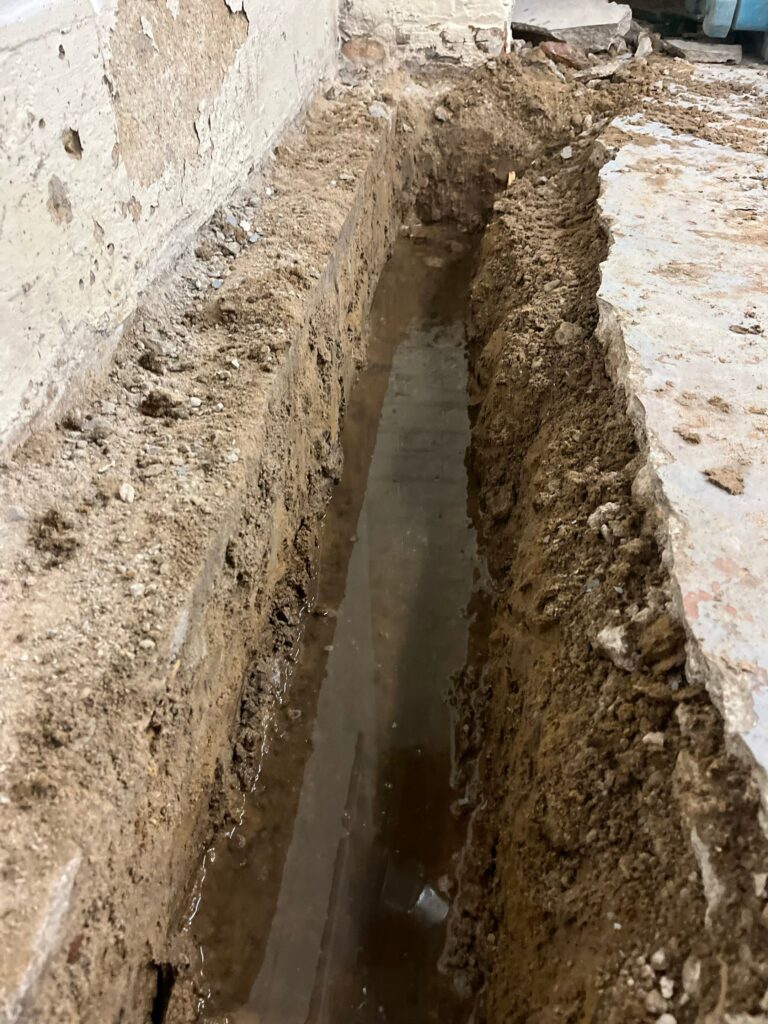
Vapor Barrier
A vapor barrier is a thin polyethylene sheet that’s wrapped around your foundation walls. This will prevent moisture from seeping through your basement walls, channeling any water into the drain tile system below.
Sump Pump
A sump pump is a fixture that sits inside a sump pit. Once water is deposited into the sump pit from the drain tile system, the sump pump will eject it from your home using a discharge line. The discharge line transports water at least 20 feet from your home in order to prevent further water seepage.
Why Is Water Coming Up Through The Basement Floor?
Hydrostatic Pressure
The main reason water is coming up through your basement floor is due to something called hydrostatic pressure. This is when water accumulates in the soil outside your basement walls or floors and pushes against them. Water can weigh around 60 pounds per cubic foot, making it a very heavy force.
Cove Joint
The most notable place water enters through is the cove joint. The cove joint is the space between your foundation wall and basement floor. Your slab and wall were poured separately, and that’s why this space exists. The only way to counter water seepage through your cove joint is by installing a drain tile system.
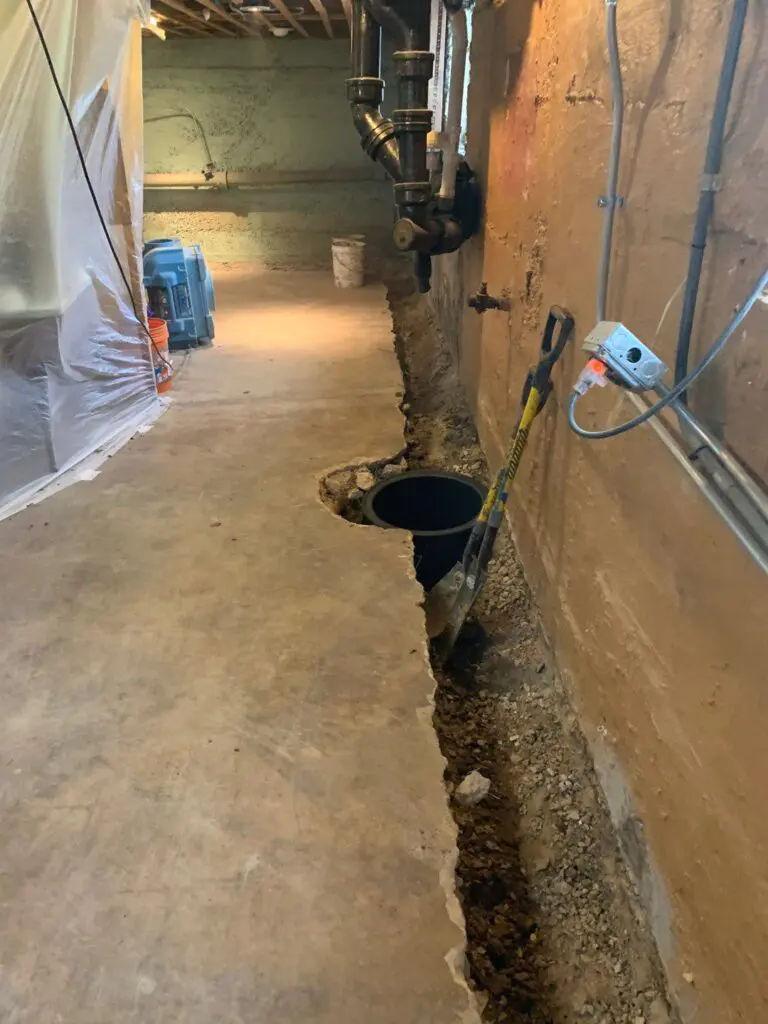
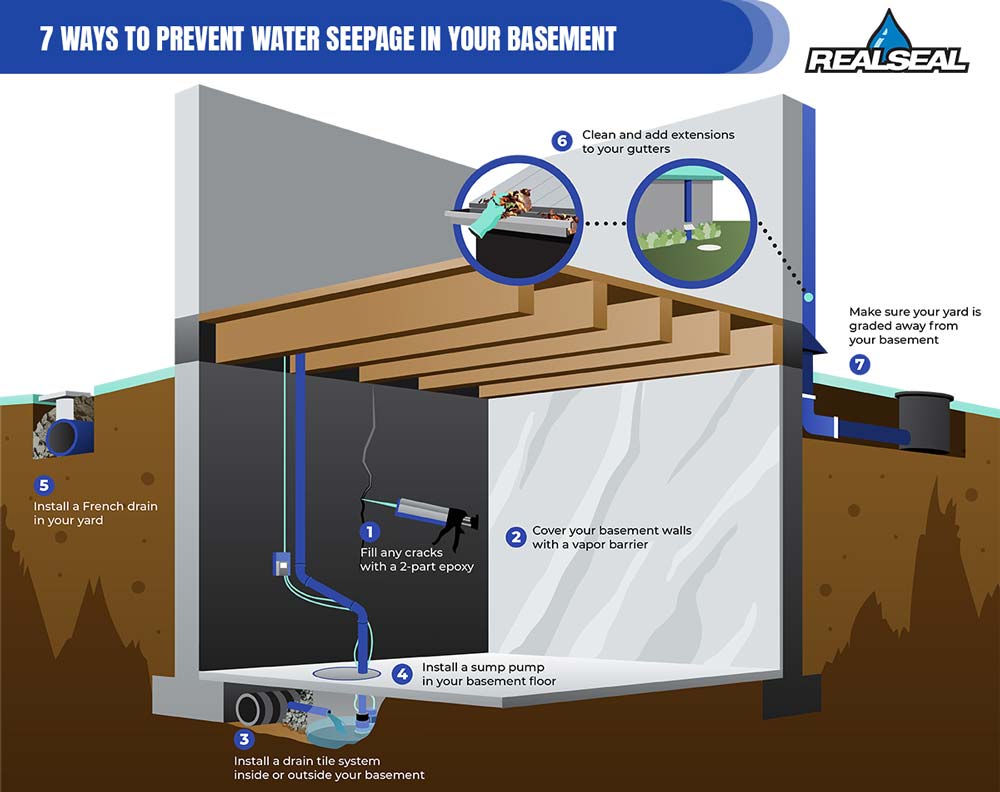
How To Prevent Water Coming Up Through The Basement Floor
You can prevent how much water comes up through your basement floor by controlling how much moisture saturates your soil. Here’s how you can do that.
Add a French drain to Your Yard
A French drain is a below-ground pipe that collects water that pools in your yard. These are very useful in preventing water buildup and puddles.
Clean and Extend Your Gutters
Gutters should not be pouring water too close to your basement. Otherwise, water will saturate the soil near your walls and floors. By extending your gutters at least 20 feet away from your home, you can stop water buildup. Also, remember to clean your gutters as often as you can to prevent water from pouring over the sides.
Grading (Sloping) Your Property Away from Your Home
If rain is draining toward your basement, water could saturate the soil near your walls and slab. You could grade your property yourself, but we recommend calling in an expert.
Is Water Actually Coming Up Through The Basement Floor?
- Tape aluminum foil over damp spots in your basement.
- Wait one day.
- If moisture forms on the outside of the foil, water is condensing from the air.
- If moisture is forming on the inside of the foil, water is seeping through your basement floor or walls.
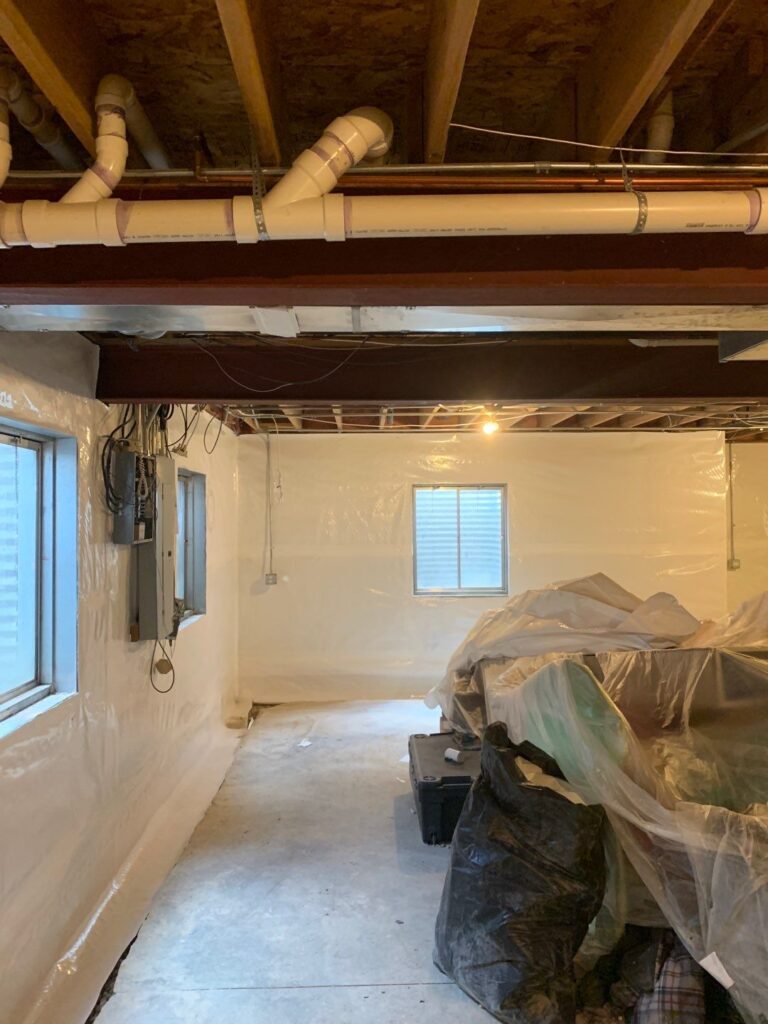
Who Can Stop Water From Coming Up Through The Basement Floor?
If you’re living in the Greater Chicago area and water is coming up through the basement floor, you should call The Real Seal Basement Waterproofing and Foundation Repair to help prevent water from coming up through the basement floor. Since 2011, we’ve been waterproofing and sealing thousands of basements and crawl spaces. Call today, and we’ll come out and inspect your basement, find out where the water is coming from, and apply the most effective solution. We also offer foundation repair, crawl space repair, concrete leveling, and more.

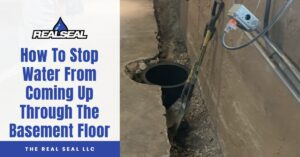
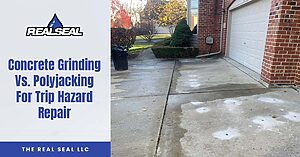
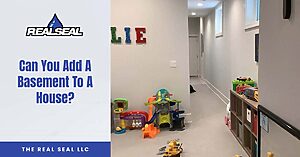
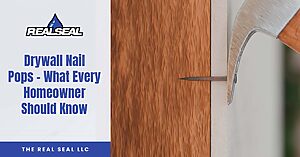
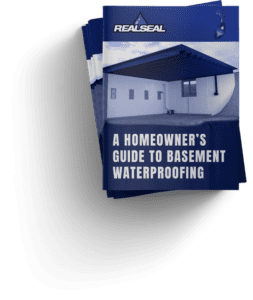

100 Responses
Can you recommend company inLA? [email protected]
Hello! Yes, we would recommend Dalinghaus Construction. If they cannot help you, they will know someone who can.
Good morning,
We are in a home that was completely renovated a year ago. Before we did any construction, we did exterior French drains around the entire exterior perimeter of our home. Unfortunately, we are getting a lot of water inside one of the front rooms of our basement to the point where I am still getting water coming in on a fairly steady basis two days after the rain has stopped. The property is graded with brand new gutters throughout. We understand that this may have to do with the water table, but we don’t understand why it’s just this front room, especially when an exterior room in the back was excavated a couple of feet lower with no water seepage at all. We were curious what you think about this.
Hi Debbie!
I’m sorry to hear you are dealing with this. Can you clarify what you mean by French Drains? Were the 4″ Perforated pipes buried just below the dirt level or all the way at the bottom of the foundation by the footing? Did the contractor grade those pipes so they sloped towards the sump pit? And do you have at least a 36″ Sump Basin? Did they coat/seal the walls before backfill?
If any one of these things were not done, you can still get water in the basement. It is essential to not only install a system, but to get a qualified contractor to install it correctly. Too many times we have had to re-do brand new systems because the contractor didn’t grade the pipe (water only moves by gravity, not well wishes), or put the holes down (much confusion on this. Holes in the pipe MUST be down or the system WILL fail), or put too shallow of a sump pit, or didn’t seal the wall.
Let me know the answers to your questions and I’ll see what I can do to help! Also, what area are you in?
I really love the way you put your answers out…it just shows how professional you are.
Kindly reach out on [email protected]
Always happy to help!
Can you recommend someone in Ogden Utah
Hello Tracy! Unfortunately we do not know anybody in that area. Sorry!
In wet/rainy seasons is it common for water to be under basement floors even though there is no seepage into the basement? My 1969 home has an exterior drain system with 3 small foundation holes to allow accumulated water to drain into a floor drain and then into a he city sewer system. The exterior drain system appears to function properly.
However, after removing some basement concrete flooring for remodeling a basement shower & toilet. With a temporary low area under the slab for the drain plumbing remodeling, water has been seeping into low area of the surrounding sand & gravel fill until the drain plumbing is finalized and the concrete floor area is re-poured.
I keep dipping out the water, only for more water under the basement floor to seep back into the hole.
So the question is, is it common for basement floors to have water under them even when the exterior perimeter drain seems to be functioning correctly? Again, I’ll he basement walls & floor are otherwise dry and no seepage or floor condensation is otherwise observed.
Great question, Randy! It actually is common for most basement floors to have water underneath them. After all, what’s underneath your floor but the Earth? And when it rains, water is present.
A Drain Tile System is designed to keep water beneath the floor level, but it does not eliminate all water underneath your home. Again, that dirt/water goes all the way to the center of the Earth! The main purpose is to keep the water level low enough that it does not come through the floor or Cove Joint.
If the only water you are seeing is underneath the floor where you opened up the slab to re-do the plumbing, I would not worry about that. If that water rises to the point where it comes through the floor, that is when you know you need to install a new Drain Tile System. The existing Clay Drain Tiles that were installed at the time of construction will collapse and clog over time. Just something to keep an eye on.
Let me know if you have any other questions!
Can you recommend someone in Almena Wisconsin? Friend’s basement is under 1″ of water and it’s still coming in
Hi Karina!
Unfortunately, we don’t know anyone up in Almena. Best bet is to compare reviews across all sites (Yelp, Angie’s, BBB, Google) to see who is consistently making their customers happy.
I have an older home in Norridge Il, 30 years ago I dug the basement floor down a foot due to a low ceiling, I found there was no footing under the concrete foundation so we formed out an interior footing at the bottom to secure the foundation , my Plumber installed Pex tube heating in the floor before the full pour, I asked him if we need to add drains or Drain Tile & he said no it will never leak, so 30 years later I still get water after heavy rains in certain places. I’m sure I need Drain Tile but in order to cut the floor I’d probably cut the Pex Heat Tubing since it goes up to the Foundation walls, the tubing could be repaired but that’s a ton of connections to splice together, Now that I rattled you a bit, what are your thoughts ?
Hi Bob!
That’s definitely an interesting one. You will need a Drain Tile to keep water from flooding your basement. In order to do so, you are correct, we will need to cut open the floor and break some of those tubes. How this works whenever we run into radiant floor heating is the plumber will need to come turn off the system before we start, repair the tubes once we have dug out the trench, and then start/test the system to make sure it’s back to functionality.
The only way to avoid this is to dig the foundation out from the outside to install the Drain Tile System. This tends to be much more expensive, and the preferred method is still from the interior.
Thank You for getting back so quick, I’d like for you to look at what I have & the best way to repair , it will be from the interior for sure. Please E-Mail me all you contact info Have a Great Easter !!
Hi Bob!
We’ll send you an email, hope you had a great Easter!
Any recs for Madison, WI?
Hi Erin!
Unfortunately we do not have any referral partners up in Madison. Let us know who you find and if you had a good experience with them!
Hi,
I have water coming from the cement basement floor. The concrete floor is very old and the water is coming up from the center as well as from the cove joint near one of the walls.
My question is:
Can placing a sump pit and pump near that cove joint (which is also the lowest part of the floor) prevent the water from coming up in the center of the room.
Should I dig into the center and place a perforated pipe running to the wall where the pit is or will the pump by the wall be enough to absorb the water underneath.
Thanks
Hi Ed!
We have some great videos of this on our media page. To be clear, a sump pit and pump in the corner will not solve your water issue. In order to capture the water in the middle of the floor, you will need to run 4″ Drain Tiles along the perimeter of the basement that lead to that sump pit. It is a large project to be sure.
How water gets in through the floor is pretty simple. You have a “bowl” in the ground where your house sits that will fill up with water in rain. As the water builds up, it surrounds the house and builds pressure. This pressure will start to push water through the concrete floor via cracks, low spots, and the cove joint. Installing the perimeter Drain Tiles that I mentioned above will keep the water from building up enough to push through the floor.
I would not suggest doing one line of Drain Tile to the center of the floor. If you plan on living in your house forever and this works, great. If you ever plan on selling, anyone coming in will, rightfully so, point out that it wasn’t done correctly. They’ll then ask for credits to install a proper Drain Tile with a warranty.
Do you have any recommendations for Petersburg VA
Hi Anthony!
You can give AMC911 Crawl Space & Foundation Repair in Norfolk, VA a call. I am not sure if they travel to your area, but they are the company we know in Virginia. Let us know how it goes!
Hello, I am happy I found your page.
We recently built a concrete house in Jamaica. After ceramic tiles were laid we realize water was seeping around the edges of the tiles leaving a yellow mark. We removed a tile and found that water was beneath the tiles on top of the concrete
flooring. We did not use any plastic on top before tiling. Only tiles in a
particular area of the house is
affected. We are in the process of
making a french drain outside.
Should we bore the pipes all the way
through? Or leave the bottom. We
recently found out that there is a
pond behind my property extending
behind my neighbour’s house as well
who is also experiencing the same
problem with his tiles. Should we
dump this pond? If the pond is
dumped will it push more water on
our property worsening the situation? Need your help please
Hi Nellene,
Jamaica is a wonderful place, congratulations on building your new home! The Drain Tiles should be around the perimeter of the home, but you can do it inside or outside. Either way, they should run to a sump pit or down a slope. You can dump into the pond nearby and it shouldn’t make your issue worse.
Thank you you have made my night I can prove to the older brother is it Warden head
Happy to help!
Hello!
Thank you for your helpful blog articles! Found your site when doing some research on possible solutions to our basement having flooded. Do you happen to know anyone in the Denver metro area in Colorado? Would love to give them a shout since you clearly know your stuff!
Thanks again,
Jessica
Hi Jessica! Thanks, we’re always happy to help! Unfortunately we do not have anyone we know in Colorado area. Let us know who you find and if you like them!
In my basement, I have a French drain that runs to a sump pump. After heavy rains, I have water seepage up through the floor in front of the drain and no dampness in the drain itself/sump pump does not run. Yard appears to slope correctly and the wall is not damp. Any idea why this happens and what can be done? Thanks.
Hi Judy!
It looks like your drain tile was installed incorrectly, unfortunately. The Drain Tile should fill with water before your floor floods, and if it is not, then there is an issue with the water getting to the tile.
This could be because the Drain Tile is set too high and level (many contractors mistakenly think that Drain Tile and French Drains are the only pipes that run water that do not require a grade. They most certainly need to be sloped to run water and this is the most common thing we see).
The only solution here would be to tear up and re-do the Drain Tile. Do you have a warranty with a company who installed it or did it come with the home?
Thanks Austin. Unfortunately this is a 30 year old townhome so no warranties.
In that case, you’ll need to reach out to a Foundation Waterproofing company in your area to get an evaluation, most likely on a new Drain Tile. What area are you in?
Hello. Thanks so much for this information. Do you have any recommendations for Baltimore, MD?
Hi Donnisha!
Unfortunately, we do not. I would suggest going on Yelp, Angie’s List, and BBB and reading the reviews and any complaints to find the best company.
Hi Austin, my house build in 2000 and I have sump pump system. However, after each heavy rain (2-3 days), I see wet spots in my basement floor. It appears in one room only. What could cause this issue? Thank you!
Hi Ragheed!
Good question. Assuming that your Drain Tile and Sump Pump were installed correctly, you are likely looking at a Foundation Crack. In the room that is getting water, you will need to take down some drywall around the area to find the source.
Hi Austin, thanks for the quick reply!
I took down a couple of drywalls and no source of water what so ever. Also, rod halls in that area are patched and no sings of water stain. The wet or (moisture) spots are only appear in heavy rain days and they are kind of away from basement walls. Any suggestions? Thank you!
Happy to help Ragheed!
If you are getting water away from the walls during heavy rain, the Drain Tile System you have in place is not doing what it was intended to. I would have a local company come out and take a look.
Water comes in the basement through 4 main channels:
1) Over the top of the foundation
2) Through the foundation (cracks)
3) Under the foundation (floor cracks, cove joint, floor gaps)
4) Sewer Backup
I appreciate all the advice and suggestions you provide….and wish you were nearby! After days of saturating rains – a lot of water does come up from the middle of my basement (1949 cape). If I’m understand correctly, I would need to have drains installed inside the perimeter of the basement to relieve the pressure and direct the water elsewhere. A couple of questions… would doing 2 sides of the basement suffice or do all 4 sides really need to be done? How can I tell that the contractor is qualified (I know, tough question if I have no referrals – which I don’t); and do you want to come to CT?! Just kidding – but do you have any recommendations for southern CT?
(I also need to remove all the water damage at base of walls). Thank you for your help!
Hi Mary Ann!
I wish we were closer too! Unfortunately we do not come out to CT or know anyone in that area at the moment. We would love to know if you have a good experience with someone so I can add them to our referral list.
To answer your questions:
1) The best way to install a Drain Tile System is to install a full perimeter system. If you are only getting water through 2 sides, it is possible to do a partial system. Just know that in the future water can find a way in the other sides that are not protected and you may need to finish the system. If you plan on finishing the basement, we highly recommend doing the full system.
2) The best way is to compare reviews (and read the reviews) across multiple sites. Some contracts do fake reviews, but it is difficult to fake them across all mediums (Yelp, Angies, BBB, Google).
Let us know if we can help in any other way!
Hi Austin. Any recommendations in the Milwaukee area? Thank you! Pam
Hi Pam! Unfortunately we don’t have anyone we know in the Milwaukee area, I’m sorry! If you do find someone and have a good experience, could you please pass their info along so we can add them to our referral list?
Hi Austin. I live in Rockford, IL. My house has a cement block foundation, built in 1928. I have water seeping up through a “opened” crack in the basement floor, & 2 sides at the floor. My question is can I get away with grading the ground instead of a drain pump system. My quote for the system is up to $8000. I have a new roof & new gutters with longer extentions at the ground. I just hate to spend that much money if there may be another solution. I am at retirement age & money is important to hold on to. Thank you.
Hi Teresa!
When dealing with seepage through the floor, a Drain Tile is the proper solution. You can try regrading and extending your gutters, but I would not hold my breath on that being the only solution. However, once a Drain Tile is installed, you will get a Lifetime Warranty against seepage in the floor.
There are some financing programs that can be utilized to help break those payments up so it’s more affordable. Once you go to sell your home, the buyers will be likely asking for a credit for that system if you do not install it.
I’m sorry I wish I could give you better news!
Hi! We have been in our room for 11 years and just started getting water in our basement. It happens a few days after a heavy rain and is only in a very small area right at the bottom of the stairs.
What could be the cause and solution?
Thanks in advance!
Hi Leigh!
It is very difficult to diagnose anything without being on-site. It could be a simple crack, over-the-top seepage from a door exit right at those stairs, or even from the Cove Joint.
The most likely of the 3 will be the crack or the over-the-top seepage. To know for sure, you’ll have to get under the stairs, and if there’s any drywall, remove the drywall, and see what is behind.
Hello Austin. i recently purchased a house in VA , during heavy rain for past 3 days my basement ground starting leaking water. i checked around the foundation walls there is no leaks or sight of any water but it’s only coming through the ground cracks. Note the house was completely renovated by a company before my purchase. it only happened when it was heavy rain for 3 days straight. Please advice on what can be the issue? Thanks!
Hi Mosen!
Water coming up from floor cracks is a seepage issue. When your home was built, they dug out a hole for the foundation. Once the foundation was poured, your house was built. This hole in the ground, though backfilled with dirt around your foundation, acts like a false water table. It’s easier for water to build up in this hole than the surrounding soil, so your home acts like a basin for water. Homes that have seepage issues need to have a Drain Tile System installed, accompanied by a sump pit and discharge line.
If your home has this, it’s entirely possible that the renovating company installed it incorrectly. We have to fix Drain Tiles from flippers all the time, as they are not very knowledgeable about waterproofing systems and usually cut that essential system out so they can make more profit on the home.
Check to see if your home has a Drain Tile and Sump Pump. Best thing to do is research a reputable company in the area to come out and perform an inspection.
Hi Austin. Would you have any recommendations for Orange County, NY (lower Hudson Valley. Also bordering NJ). Live in Warwick Area. Thank you.
Hi Catherine!
The only contractor we know in that area would be AM Shield. Hugo is an expert and runs a well-oiled company.
Hi Austin, can you recommend a contractor in the Rhode Island area ?
Thank you,
John
Hi John!
Unfortunately we do not have any trusted contractors in the Rhode Island area. My suggestion would be to go online and compare reviews against Google, BBB, Yelp, & Angie’s List and find the contractor that is most consistent among all of the sites. Google is easy to fake, but Yelp and Angie’s are not. Read all the BBB complaints as well, as the BBB no longer is there for the consumer as much as they are for businesses, so the rating system leaves something to be desired.
Hi Austin,
I take care of a building that has a water seepage problem whenever we get heavy rain for a prolonged period of time. One of the downspouts was discharging onto the ground 5 feet from the building and I thought that was the cause. I dug in a drainage pipe to the street 30 feet away but there is still water coming in. This building has been added onto a couple of times. There are basically two foundations. One, which is now the exterior of the building and the original one that is about 20 feet inside of that. The water is seeping up where the old interior foundation meets the poured concrete floor. I just don’t understand how the water can get through two foundations and then still have enough pressure to come up through the floor. Do you have any thoughts about that. Thank you for the great article and your time.
Myles
Hi Myles,
This is actually very common. Water can build up around your home and will come up through the floors. This happens mainly because the “bowl” that was dug out for your foundation collects water similar to a water table. This false water table retains water quicker than it can dissipate through the soil. The water then forces itself where it will go (many times through the floor and wall).
The solution to this would be a Drain Tile System. Especially if it’s been added onto a few times, it is likely a full perimeter Drain Tile is not present, or if it is, it is installed incorrectly. If you had a full Drain Tile, the water would not be able to come up through the floor.
What area are you in? We are in Chicagoland, so if you’re there we can come out and perform an evaluation for you. If not, we may have a referral we can send your way depending on where you are.
Hi Austin. Unfortunately I’m in Reading Pa, Do you know anyone out this way.
In Pennsylvania, we would recommend Worthington Waterproofing. Family-owned, honest, and will pay attention to your needs.
Hi. Do you know any companies in Rhode Island area? thank you.
Hi Lexie,
Unfortunately we do not have anyone we would recommend out that way. I would suggest going through Yelp, Google, Angie’s, and BBB and comparing reviews across all sites. Read the reviews, read the complaints, and go with the companies that have the best consistent reputation along all mediums. Google is easy to fake, so be sure you compare against the others.
Good day, anyone in Connecticut you recommend?
Hi Mike!
Unfortunately nobody in Connecticut that we would recommend. Try comparing reviews on the major sites (Yelp, Google, Angie’s, BBB) and go with the most consistent positive company you can find.
Great explanation. Any referrals for the Harrisburg PA area?
Thanks, Kevin!
For Pennsylvania, we would recommend Worthington Waterproofing. Family company, good honest people.
Any recommendations in the greater Boston, MA area? Thank you.
Hi Nick!
Unfortunately we do not have any trusted referral sources in that area. Best to compare any company you have out across all review sites (Yelp, Angie’s, BBB, Google). Be sure to read the reviews to get the best information!
Enjoying your comments! Have a 1920 home and water is percolating thru a small half dime size hole from basement foundation, with leaking through 2 baseboard walls. How long can a foundation sustain this before repairing. Seems to be a very busy time and no one’s available for weeks.
Also, any recommendations in Michigan?
Appreciate any input!
Hi Cathy!
Yes, it is a very busy time. With the unseasonable warmth and rain that we just experienced, most Waterproofers in the Midwest are backed up a bit.
Your foundation can handle that leak for a while, so it is worth the wait to get a reputable contractor out to evaluate. We currently do not have any recommendations in Michigan, unfortunately. However, you can find a good contractor by comparing reviews and complaints across Yelp, Google, Angie’s, and BBB. Be sure to read the reviews and any complaints on the BBB so you can see how the company handles problems. Good Luck!
Do you have any recommendations for the SE Michigan area?
Hi Ann!
Unfortunately we do not have anyone to refer in that area. Best bet is to compare (and read!) the reviews across Yelp, Angies, Google, and BBB. Be sure to read any complaints on BBB, as it will show you how the company will respond to issues.
Hi, I’m in se Michigan looking for a company. Did you have the work done?
Hi Nathsn, we unfortunately do not have anyone in Michigan. Maybe Ann found someone!
All over sudden my basement carpet getting wet and don’t know where the water came from. Do you know what might be the source of that matter?
Hi Jabeinser,
Unfortunately that is like diagnosing a sound under your hood over the phone with a mechanic. In a finished basement, everything is under the hood, and the hood will need to be opened in order to determine the source of the water. Best to try to trace the water to a wall. If you are unable, it’s likely coming through the floor, which would indicate a Sump Pump or Drain Tile issue. Best thing to do is bring in a qualified contractor to check it out!
I have water seepage along cement crawl space edges. A few small cracks forming across floor also with seepage. 2 sump pumps. The pumps work when water does reach them. I also hear the pumps going off many times throughout the day, even when I don’t have standing water. But I am told there are no drain tiles under or surrounding my house that bleed into the sump pumps. Apparently there are no pipes that lead into pump wells from what would be drain tiles. I have been quoted prices for inside drain tiles, which would mean breaking up the floor around all of the edges, and also another company that told me I need inside and outside tiles. Trenches dug, piped placed, new well for the sump pump and then stone. If it’s done correctly, why would I need inside and outside drain tiles, which would be approximately the width of the cement block walls away from each other (inside and outside) Located in SW Michigan.
Hi J Ann F!
Good questions. So sump pumps without drain tiles are essentially cars with engines, but no tires. While the sump pump can pull water from around the area, it will never be as effective as a full Drain Tile System.
You do NOT need both Interior and Exterior Drain Tiles. That company is trying to pull a fast one on you for sure. Do not use them.
You should get Interior Drain Tile. It will be the most cost effective solution for your issue. They will need to break out the interior perimeter of the floor (about 12-18″ from the wall only) to lay the Drain Tiles next to the footer of the foundation. They will bury it in gravel and re-cement over when they are done. This video shows how a Drain Tile is installed.
https://youtu.be/NabEh6UOgn8?si=uGtuKi3B0YsCf1G7
Do not hesitate to reach out with any questions. We are big on protecting people from getting scammed. And unfortunately, there are a lot of waterproofers out there that are scamming people with work they don’t need, using fear and pressure tactics to trick and force them to sign a contract. We’re here for you!
Hi Austin:
We did an extension in our basement where we created a kitchen area, stove, fridge, cupboards dining table etc. We put down moisture flooring (looks like wood). Water keeps seeping through the creases in the flooring when we have rain. Last night water came rushing out the flooring of the floor molding, I felt like a river had burst. We had so many different people gave suggestions and we have tried to fix it and nothing so far has help. We have dug up and resealed the outside back yard because we were told it was not sealed that is why water is coming in, this did not work. We had the cutter clean, reseal the walls with some sort of solution. We had someone here today and they say to open the wall to see where the water is coming from and keep it open until the rain falls. Some one said to put in a sump pump. We have drained our saving trying to fix this issue. We are here in Brooklyn, New York. Do you know anyone you can recommend. Or do you have any suggestion for us. Thank you!!
Hi Deborah!
I’m sorry you’re dealing with this. It is never a fun situation. While you seem to have done all the good things to help reduce the water flow, your ultimate solution is going to be a Drain Tile System. This is a 4″ perforated pipe laid under the floor around the perimeter of the basement. You can try opening the wall, but from the amount of water you are signifying, I would think it was a Drain Tile issue as opposed to a Foundation Crack or Over-The-Top Seepage.
But if you’re looking to save money first, you can open the wall in that area and see where the water is coming from. If you see it coming down or through the wall, you have a Foundation Crack or Over-The-Top Seepage. If it is coming from where the floor and the wall meet, it’s a Drain Tile issue.
Hugo D’Esposito with A.M. Shield Waterproofing can help you out in that area. He is a good guy and has a good company.
Thank you for this article. We have a new construction home that is about a year old. In the basement, there’s a sump pump that activates when water gets in the sump. We had heavy rains in 2023 but the sump pump never activated and all seemed fine. In January 2024, a few days after about 6 inches of snow, the sump pump started pumping water. It started at 15 minutes interval and over the months the time range steadily went down and we are now about 40 seconds interval. Since January 2024, our sump pump has been actively pumping lots of water from the basement. Not only that, the sump pump broke in early April and unfortunately, the backup failed to pick up leading to our basement being flooded. Our basement was cleaned up and a new sump pump was installed and it still pumps out lots of water every 40 seconds. We live in Delaware, US. Is there anything that can be done to resolve this? My husband says nothing can be done . Our house is located downgradient in the community and only ours and a neighbor are experiencing this issue. I’m unsettled as I think the sump pump will break again. Any advice/insights?
Hi Jade!
You have a normal situation from the sound of things. Many houses sit in areas that have changing water tables with the season. The point of the sump pump is to go off and pump any water from underneath the home to prevent the basement from being flooded. If you want your pump to go off less often, the best thing you can do is extend all your gutter downspouts, ensure your yard is graded away from the home, and bring the sump pump discharge far away from the home to prevent recirculating of the water.
Other than that, the sump pump should be going off. I would suggest a quality battery backup system. Not the ones you buy at a big box store, but one with at least a 5 year warranty and an app that reports the status and date of the sump pump system. This way, you can get ahead of any issues before your basement floods.
Hello! I’m in Morris, IL. About an hour southwest of Chicago. Do you service our area? We are in desperate need of help with our cove joint and cracks in our basement floor.
Hi Christine! We do absolutely service Morris. Give us a call! 847-756-7987
I have a strange storage area under my basement stairs that is actually a few inches lower that the rest of the basement. It’s difficult to access because you actually lift the heavy stairs to enter (very creepy). But water seeps in here and it’s causing mold. The floor area has about 1/4-1/2” of water at all times unless it’s drought-like. This is a walk-out basement and we have upper and lower French drains that keep everything else dry. I feel like I should raise this low spot to match the rest. Water absolutely seeps in from that joint between exterior wall and slab. Any ideas?
Hi Stacy!
Sorry you’re dealing with this, sounds like a pain! Those stairs seem fun, but definitely an issue with the standing water.
When you say you have a walk-out basement with upper and lower French Drains, do you mean that you have a Sump Pit with a Drain Tile System? French Drains typically are just below the surface in the yard and do not stop the basement from flooding.
If you do have footing Drain Tile and that is the only area that is leaking, I would suggest breaking/re-pouring the concrete even with the floor.
If you do NOT have footing Drain Tiles, those will need to be installed in order to stop this.
Thank you for the advice. The basement is underground on one side, but open to patio on the other side. Basically built into the side of a hill. I am not aware of any sump pump or drain tiles. I guess I’m looking at adding that, but I was hoping that pouring concrete would just displace the water to the French drains. Thanks for the info
Happy to Help! Yeah, even with those walk out basements you do need to have Drain Tile in order to keep the water from coming up from through the floor.
I just happened to find your page when doing a panicked search after realizing the house we just bought has major water issues. We were planning to finish the basement but may end up having a ton of work done to stabilize the house (before even considering doing anything to the basement). I will be back with specific questions, but so happy to have found this. Do you happen to know someone good near Raleigh or Durham NC?
Thank you!
Hi Emilie!
Sorry you’re dealing with a water issue after purchasing your home! Unfortunately we do not have a recommendation for that area. Best bet is to research reviews across Yelp, Angie’s, and BBB to see who has the most consistent reputation.
Hi Austin.
You ever lift the existing basement slab to accommodate raising sea levels. We live near the beach and have a full(unfinished)basement with 2 sump pumps and drains. Unfortunately, our basement is continuously still getting wet and we are pumping out for days every time it rains hard.
Someone mentioned that they heard of cracking the existing slab and installing a gravel mid-layer underneath a “new” floor a few inches higher so the sump pump can be lifted, and any water mitigated into the gravel layer without having to continuously pump out.
Will this work?
Hi Bruce!
Great question. In theory, it can work. The thing is, when you’re close to a sea, there is little you can do to keep water out of a basement. Even if that is a foot or two higher, you’re still below the water table there and you will be constantly pumping out water. This is the main reason that most homes in Florida do not have a basement. It’s just too wet underground.
Do you know of a reliable service in the Detroit metro area of Southeast Michigan?
Unfortunately not, but online review sites will help you to get a clearer picture of the right contractor to use.
Hi Austin,
I live in Northen New Jersy. I have 2 crawlspaces (on right and left side) and basement in the middle. I have a small hill in the back and has a slope towards rear of the house.
After heavy rain, I regularly see water coming in both crawlspaces where the floor meets the wall and major in the corner of both crawlspaces. I have a French drain in the basement (done by previous owner) in the basement, but I do see water on the bottom part of the rear basement wall. some Please note that the basement floor is a floating floor (there is a gap between floor and the basement wall). I never see water on the floor.
Can you please recommend what to do? Is water coming from outside or underneath the floor?
Hi Suchit,
From what you describe, it sounds like you are going to need to have someone evaluate the Drain Tile that was installed by the previous owner. The Drain Tile should run the full length of the perimeter of the crawl space and you should also have the crawl space encapsulated to re-direct any water into that system as well as keep humidity down.
Hi,
I’m super impressed that you answer all these comments.
I had a French drain installed around the inside perimeter of the home 7 years ago. I’m now getting water coming up from the basement floor but it’s no longer happening at the cove joint but rather 2 ft from the wall.
What could cause this?
Hi Brent!
Thank you! Did you have the Drain Tile installed around the entire perimeter? If you didn’t do the full perimeter, it could get in through the middle.
If you did the full perimeter, the company who did so should have a Lifetime Warranty on the system and come service it. It could be an issue with the Sump Pump malfunctioning and/or not keeping up.
The idea behind the Drain Tile is that it captures the water below the floor level before it has a chance to come up. Was the system a true Drain Tile or did they install one of the “top-of-the-footer” drains instead? Many basement floors slope towards the middle, and if you did a top of footer system, it won’t be effective during heavy rains.
Let me know!
We live in a row house with the house adjacent to an alley. We had a drain installed around the perimeter of the house exposed to the elements but not the parting wall. I guess it prob was a top of the footer drain as it didn’t seem to go too deep prob 4 inches past the floor sloped to the sump pump.
We’ve had heavy rains in the past and it’s always held up but now it seems to have failed. The sump pump is working fine as I tested it to make sure.
If that is the case what’s the next remed?
So if you just have the middle of the floor that’s leaking, you could try doing a line of Drain tile across the middle of the floor directly to the sump pit.
If you did have a top of the footer Drain Tile, the other option is re-doing the perimeter tile with a Next-To-Footer Drain Tile. That would be lower and would be much better at capturing that water from the middle of the floor.
For me, I’d start with the middle section to the sump pit (1st option) as it’s easier and less expensive.
Thanks Austin, I really appreciate the time you take to answer these questions.
Of course, Brent! Let me know what you end up doing, I’d love to see how it all turns out!
Do you have any recommendations in Iowa?
Hi Jodi!
Unfortunately we don’t have anyone in Iowa we personally know. Best way to find a good contractor is to compare reviews across multiple sites (Angie’s, Yelp, Google) and find the most consistent solid reputable company.